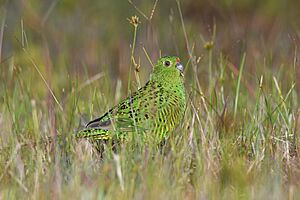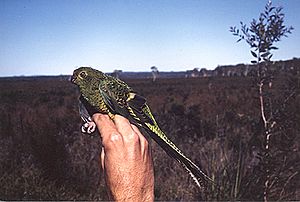Ground parrot facts for kids
Quick facts for kids Ground parrot |
|
|---|---|
 |
|
| Subsp. flaviventris | |
 |
|
| Subsp. wallicus | |
| Conservation status | |
| Scientific classification | |
| Genus: |
Pezoporus
|
| Species: |
wallicus
|
| Subspecies | |
|
|
The ground parrot (Pezoporus wallicus) is a special parrot that lives only in Australia. It is one of only four parrots in the world that mostly lives on the ground. The others are the night parrot, the Antipodes parakeet, and the kākāpō from New Zealand.
Ground parrots are yellowish-green with darker stripes. This coloring helps them blend in with the plants. They look a bit like a wild budgerigar on their head and back.
When something scares a ground parrot, it flies quickly just above the ground. Then it drops back into the plants to hide. You might only know it's there from its calls. At dawn and dusk, it makes a clear whistling sound. The sound gets higher in pitch before fading away. It does not make any noise when it flies.
The IOC World Bird List currently recognizes three types, or subspecies, of ground parrots. These are the eastern ground parrot, the western ground parrot (also called Kyloring), and the Tasmanian ground parrot.
Contents
What the Ground Parrot Looks Like
The ground parrot is a medium-sized bird. It can grow up to 30 centimeters (about 12 inches) long. It weighs around 80 grams (about 2.8 ounces).
It has bright grass-green feathers. Its head and neck have black streaks. It also has bright yellow bars on its wings. Its belly, thighs, and under-tail feathers have black and yellow stripes.
Its eyes are pale yellow. Its beak is dark grey, and its legs and feet are pink. A bright red band above its beak is a special feature. Male and female ground parrots look very similar.
Young ground parrots are a bit smaller than adults. Their feathers are a duller yellow-olive color. They do not have the red band above their beak. Their markings on the head and chest are thicker and bolder. When they first leave the nest, their eyes are dark grey-brown.
The eastern and Tasmanian ground parrots have thicker black markings. These are on their head, neck, and belly. The western ground parrot has thinner markings.
Ground Parrot Family Tree
The ground parrot belongs to a group of birds called Pezoporus. This group also includes the night parrot. The name Pezoporus comes from an old Greek word. It means "walking" or "going on foot." This makes sense because these parrots spend a lot of time on the ground!
Ground parrots are part of a larger parrot family called Psittaculidae. These are often called Old World Parrots.
There are three types of ground parrots that scientists recognize:
- P. w. flaviventris: This is the western ground parrot. It is also known by its Indigenous Noongar name, Kyloring.
- P. w. wallicus: This is the eastern ground parrot.
- P. w. leachi: This is the Tasmanian ground parrot.
The western ground parrot was once thought to be a separate species. But scientists now believe it is just a different type of the same species. This is because they look very similar.
Where Ground Parrots Live
Ground parrots live only in Australia. Each type of ground parrot lives in its own separate area.
The eastern ground parrot lives in small groups. You can find them in coastal areas of south-eastern Queensland, New South Wales, and Victoria. They used to live in South Australia, but they are no longer found there. These parrots like dry or moist coastal areas. They prefer places with thick plants like heathland or sedgeland. They need lots of their favorite food plants.
The western ground parrot lives in only two separate places in southern Western Australia. One is in Fitzgerald River National Park. The other is in Cape Arid National Park and Nuytsland Nature Reserve. They live in low, dry, or swampy heathland near the coast. They usually pick areas that have not had fires for a long time.
The Tasmanian ground parrot lives only in Tasmania. This island has the largest number of ground parrots. Scientists think there are more than 100,000 birds there.
Life Cycle of the Ground Parrot
Ground parrots usually breed from July to December. Sometimes, they lay eggs in March too. Unlike most Australian parrots, they do not nest in tree hollows. Instead, they build their nests on the ground.
They hide their nests under thick plants. These can include sedges, ferns, and shrubs like Banksia or Leptospermum. The nest is a shallow dip in dry earth. It is lined with leaves and stems.
The eggs are shiny, white, and oval-shaped. They are about 2.5 to 2.7 centimeters long. A female usually lays 3 or 4 eggs. But she can lay anywhere from 2 to 7 eggs. The female sits on the eggs for 21 to 24 days. If the first eggs do not hatch, she might lay a second set.
The male parrot brings food to the female and the baby birds. The chicks leave the nest when they are about 20 to 28 days old. They stay close to the nest and their father for at least three more weeks.
Protecting Ground Parrots
Overall, the ground parrot is listed as "Least Concern" by the IUCN Red List of Threatened Species. This is because there are many of them across a large area.
However, some types of ground parrots are in trouble. The western ground parrot (P. w. flaviventris) is listed as "Critically Endangered". This means it is very close to disappearing forever. There are fewer than 150 of these birds left in the wild. This makes it one of Australia's rarest parrots.
The eastern ground parrot (P. w. wallicus) is listed as "Vulnerable" in New South Wales and Queensland. This means it could become endangered if we don't protect it. In South Australia, it is listed as "Endangered", even though it no longer lives there. The last time it was seen in South Australia was in 1945.
The ground parrot is also listed in "Appendix I" by CITES. This means it is a highly protected species.
See also
 In Spanish: Perico terrestre oriental para niños
In Spanish: Perico terrestre oriental para niños



